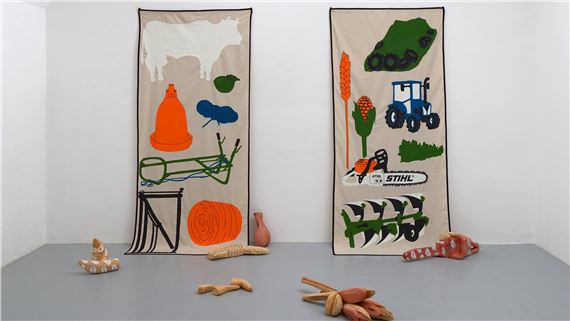Artists And Farmers
The "Artists and Farmers" exhibition explores the rich and varied connections between artists and farmers, through the spectrum of the challenges facing the agricultural world today. Bringing together some 150 artworks, the exhibition aims to give context to and emphasize the intersections between art and agriculture, while examining the way in which this exchange has developed as the relationship between humans and their environment has been redefined.
In recent years, some artists have sought to go beyond the idealised and sometimes limited view of the rural world portrayed in the Épinal images, to instead look at the social, economic and environmental realities faced by farmers today. These artists are seeking to better represent and understand a group of people who are at both the centre of society and its margins, and who, after having comprised the majority of the French population for centuries, today carry out their profession bound by the twin contradictions of increased productivity and a respect for nature. Although the years after the Second World War marked a decisive turning point for agricultural production in the West, shifting to an intensive and industrial model, the early twenty-first century has seen a time of unprecedented transformation and new understanding.
This exchange between art and agriculture conveys essential perspectives and words on the current challenges facing those who work the land. Taking a thematic approach, the exhibition addresses issues of how farmers are portrayed, seeds and the making of landscape, as well as farming practices and know-how, bringing to the forefront both historic and emerging artists who have placed the figure and the work of farmers at the heart of their artistic practice. In particular, it re-examines the arrival of the rural world into museums in the 19th century through the work of painters such as Jean-François Millet, Rosa Bonheur and Jules Breton, whose artworks the Musée d’Orsay has exceptionally agreed to loan. With their interest in the outdoors, the countryside and animals, these artists introduced portrayals of farming life and work into the field of fine arts. The twentieth century saw a continued interest in and a desire to preserve this rural way of life through the creation of museums of ethnology and traditional practices, which are represented here thanks to important loans by the Mucem (Marseille). It is this way of life that is being reinterpreted by artists today.

Recommended for you
The "Artists and Farmers" exhibition explores the rich and varied connections between artists and farmers, through the spectrum of the challenges facing the agricultural world today. Bringing together some 150 artworks, the exhibition aims to give context to and emphasize the intersections between art and agriculture, while examining the way in which this exchange has developed as the relationship between humans and their environment has been redefined.
In recent years, some artists have sought to go beyond the idealised and sometimes limited view of the rural world portrayed in the Épinal images, to instead look at the social, economic and environmental realities faced by farmers today. These artists are seeking to better represent and understand a group of people who are at both the centre of society and its margins, and who, after having comprised the majority of the French population for centuries, today carry out their profession bound by the twin contradictions of increased productivity and a respect for nature. Although the years after the Second World War marked a decisive turning point for agricultural production in the West, shifting to an intensive and industrial model, the early twenty-first century has seen a time of unprecedented transformation and new understanding.
This exchange between art and agriculture conveys essential perspectives and words on the current challenges facing those who work the land. Taking a thematic approach, the exhibition addresses issues of how farmers are portrayed, seeds and the making of landscape, as well as farming practices and know-how, bringing to the forefront both historic and emerging artists who have placed the figure and the work of farmers at the heart of their artistic practice. In particular, it re-examines the arrival of the rural world into museums in the 19th century through the work of painters such as Jean-François Millet, Rosa Bonheur and Jules Breton, whose artworks the Musée d’Orsay has exceptionally agreed to loan. With their interest in the outdoors, the countryside and animals, these artists introduced portrayals of farming life and work into the field of fine arts. The twentieth century saw a continued interest in and a desire to preserve this rural way of life through the creation of museums of ethnology and traditional practices, which are represented here thanks to important loans by the Mucem (Marseille). It is this way of life that is being reinterpreted by artists today.
Artists on show
- Adrián Balseca
- Agnes Denes
- Agnès Varda
- Annabel Guérédrat
- Asunción Molinos Gordo
- Aurelia Mihai
- Aurelie Ferruel
- Aurélie Olivier
- Damien Rouxel
- Daniel Otero Torres
- Daniel Spoerri
- Ed Davenport
- Emilie Pitoiset
- Eric Tabuchi
- Fabrice Hybert
- Florentine Guedon
- Gianfranco Baruchello
- Hassan Musa
- Henri Cueco
- Jade Tang
- Jean Amblard
- Jean-Baptiste Perret
- Jean-François Millet
- Jules Breton
- Julien Beneyton
- Kako
- Karoll Petit
- Léon-Augustin L'Hermitte
- Lois Weinberger
- María Teresa Alves
- Marinette Cueco
- Mathieu Asselin
- Mathilde Caylou
- Michel Blazy
- Morgan Fache
- Morgane Denzler
- MyVillages
- Nelly Monnier
- Nicolas Tubéry
- Nina Ferrer-Gleize
- Noémie Sauve
- Pascal Rivet
- Pierre Creton
- Rosa Bonheur
- Simone Villemeur Deloume
- Stéphane Kenkle
- Stéphanie Sagot
- Suzanne Husky
- Sylvain Gouraud
- Tabita Rezaire
- Terence Pique
- Thierry Boutonnier
- Tony Morgan
Contact details


 ARTISTS
ARTISTS












